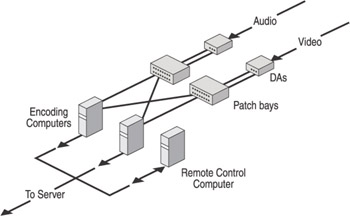Configuring Live Encoders
The Fabrikam staff first mount the three computers in a rack in the machine room, and then wire them to the KVM switchbox in the control room. The diagram in figure 18.5 shows a simplified view of the signal flow.

Figure 18.5: Configuration of computers and equipment in the Fabrikam studio.
From the main outputs of the audio mixer and video switcher, the signals are split by DAs, and then sent to the patch bays. From there the signals can be routed or patched to a number of destinations, including the two encoding computers. The encoded Windows Media streams are then sent to the servers.
The remote control computer is also connected to the servers over the network. The audio output of the computer is fed into the control room mixer so that the broadcast audio can be monitored. The audio output will not be monitored continuously because of the delay added by Windows Media Player and the encoders.
Most of the inputs and outputs in the facility are wired into the patch bay to simplify signal routing. Figure 18.6 shows a section of the video patch bay. Outputs are typically on the top row; inputs are on the bottom row. The DA outputs show up at the patch points labeled DA1 through DA4.

Figure 18.6: Typical layout of a video patch bay.
The patch bay is laid out so each output can be “normalled” to the input below it, meaning the output is connected internally to the input unless a signal is rerouted with a patch cord. In this patch panel, the four DA outputs are normalled to the encoding computer inputs and VCR inputs. The outputs of the two VCRs, two cameras, and the character generator are normalled to switcher inputs SW1 through SW5. BUS1 and BUS2 are the two video lines to the compression suite, and they are not normalled. You can, for example, patch the output of a VCR or DA to BUS2, and then patch that signal into one of the encoding computers in the compression suite. The audio patch bay is similar.
Computer Specifications
To encode live streams, the Fabrikam studio will use two dual-processor computers with 256 MB of RAM and 20 GB hard drives. Both computers will run Microsoft Windows XP Professional. Windows Media Encoder 9 Series will be used to encode.
In addition to encoding live streams, the computers can be used to save archive files, so they will need large hard drives. However, Fabrikam will not use the hard drives for long-term storage.
The only additional hardware each computer will need is a video capture card. The 100-Mbps network interface card (NIC) is typically included on the computers. To save money, Fabrikam will use desktop-style computers placed on shelves mounted in the rack.
For the remote control computer, Fabrikam can use a less-powerful, single-processor computer running Windows XP Professional. This computer will be used to control the broadcast publishing point with the Windows Media Services Administrator for the Web, and to check playback of the encoded stream. They can install the three computers in the rack first, and then install and configure the software. They will name the computers LiveEncoder01, LiveEncoder02, and RemControl.
Encoding Appliances
Several manufacturers, such as Winnov and Pinnacle, offer dedicated encoding appliances. An encoding appliance simplifies setup and operation because all it does is encode multiple streams. Most appliances are designed to be rack-mounted and offer additional production features, such as Web-based remote management and monitoring. You simply plug in the audio, video, and network, configure the encoders, and then start the encoders running.
The main downside of an encoding appliance is that it might not meet corporate platform and security standards, or enable you to easily upgrade the encoder and codecs.
EAN: 2147483647
Pages: 258